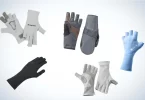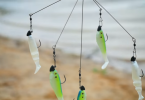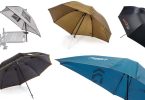It is frustrating to have a spinning reel but does not know about the usage of the equipment.
The reel comes with numerous features and settings. Reels might vary in setting, but the usage and the purpose of use remain the same. However, the reel is undoubtedly tough to set up and utilize.
The spinning reel and rod are the significant components, and one must utilize them in the initial stage of the fishing. The below-mentioned instructions would enable you to use the spinning reel properly and have great fishing.
Here we begin!
Step 1: Gather your Equipment
-
Spinning reel.
It would be best if you first needed to buy a spinning reel that would suit you better.
-
Spinning rod.
Spinning rods are accessible according to the spinning reel, so you need to check if both reel and rod suit each other.
-
Fishing line.
Choosing a reel type is not an easy task; you have to determine the fish type you want to capture before purchasing a fishing line.
-
Lure/hook.
The type of lure you use depends upon the fish. Have complete knowledge before you go fishing.
-
Scissors.
Ordinary scissors will work for it.
Step 2: comprehend the Essential Components of the Spinning Reel and Rod
-
Spinning Reel
-
Spool
The fishing line is wound around the spool.
-
Handle
The turning handle retrieves the line and enables it to remain in the reel.
-
Drag knob
The drag knob enables to set the line quickly, and it comes out of the spool having the closed bail.
The tightened knob would not allow the line to come out of the spool, whereas the loosened knob would enable the line to come out effortlessly.
-
Bail
It is a metal arm from which the line comes out. When the bail is closed, the line cannot move, whereas the line comes out freely when the bail is open.
-
Line roller
It keeps the line straight and tangle-free from the spool to the rod.
-
Reel foot
The reel foot conveniently attaches to the rod.
-
Fishing Rod
-
Rod tip
The thinnest part of the rod at the end enables the angler to feel the fish bite.
-
Reel seat
It connects to the reel to maintain it from the reel to the rod.
-
Guides.
It maintains the closeness of the line and the rod; these are the circles from where the line passes.
-
Handle.
The handle is the thing that you hold throughout the fishing, so it is of soft material like rubber that enables the easy grip.
Step 3: Adjust the Reel on the Rod
1. Loose the reel seat on the fishing rod.
Tip: Open the reel seat enough to fit the reel foot.
2. Put the reel foot in the reel seat.
3. Tight the reel seat.
Step 4: Spooling the Reel
It is an essential step to spool or put the line on the reel. If the angler did not do it properly, the user might have difficulties.
-
Open the bail on the spinning reel.
-
Put the line all over the reel.
-
Knot the two pieces (the line connected around the reel) of the line.
-
Bind one more knot with the pieces of the line.
-
Use the scissors to cut the unfastened piece of line that is 1/4″ approx. apart from the reel.
-
Close the bail.
-
Hold the line tightly, a foot apart from the reel.
-
Rotate the reel to take the required line on the reel.
Step 5: Stringing the Rod
1. Hold the line’s tip with a single hand.
2. Use the second hand for opening the bail arm.
3. Put the line from every rod guide.
Tip: Start stringing the rod from the bottom guide to the rod tip. It would work properly through the fishing.
Step 6: Tying the Knot
Tie the knot properly so that it would stay for a long time. The different complicated knots would work well when the fish is heavy. The bigger fish would pull the line, and it could easily loosen the knot. Making a sturdy knot is one other necessary aspect to consider.
-
You have to put the line from the bait’s eye to have a single piece of line on each bait’s side.
-
Cross the one piece over the other hand by holding each line’s piece in each hand.
-
Put the line’s hanging piece via the loop.
-
Knot tightly by stretching the line’s ends.
-
Repeat the 4th step 3 times to guarantee the knot will not lose.
-
Cut the loosened line 1/4″ apart from the hook’s eye.
Step 7: Setting the Drag Knob
-
To tighten the drag knob, rotate it clockwise; for loosening it rotate it anti-clockwise.
-
Pull the line from the reel with your hand to check the effective part of the drag.
-
Repeat both the 1st and 2nd steps till the drag gets its required place.
Setting the drag is tricky; you need some expert advice to do so. If any expert is not available, then you could set the drag on the loose side, as the tight setting would make the reel break easily.
It is essential to set the drag before you start fishing; if you face any problem during fishing, you can adjust the drag. The signs of improper drag setting are mentioned here:
-
If the drag is loose, the fish could easily take the line out of the reel.
-
If the drag is tight, they cannot take the line out, but the rod results in bending.
Step 8: Casting the Bait
1. Enable about 1 to 1 1/2 feet line to hang from the rod tip.
2. Use a hand to grasp the rod a few inches from the reel’s base and the line parallel to the fishing rod.
3. Use another hand to open the bail.
4. Grasp the bottom of the rod by using the same hand as in the 2nd step.
5. Apart from the target, tilt the rod backward.
6. Free your hand from the 1st step by swinging the rod towards the target at the cast’s top.
Step 9: Reeling the Line
1. Close the bail.
2. Put the line in the line roller.
3. Rotate the handle of the reel.
There are different strategies to reel the line. It usually depends upon the fish, the weather, the time, the water condition, and the type of bait you are using. The reeling is possible at several speeds; you can reel in fast or slow, which does not matter at the constant. There is no ordinary rule to reel the line; you need to choose the reeling style according to your demand.
Step 10: Catch the Fish; your Reel is Ready for Fishing
Cheers! You have gone through all the steps, and now you know how to fish. These guidelines have aided you a lot in getting everything about the reel usage. It is time to the advantage of the fishing and gets your work hard in the form of a successful fishing experience.
Go! Catch Your Desired Fish!








